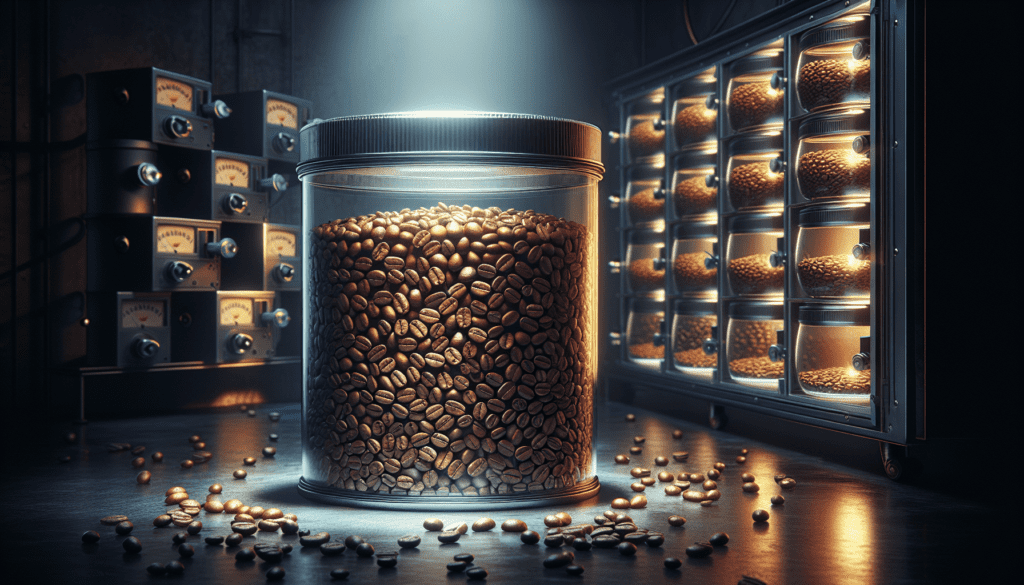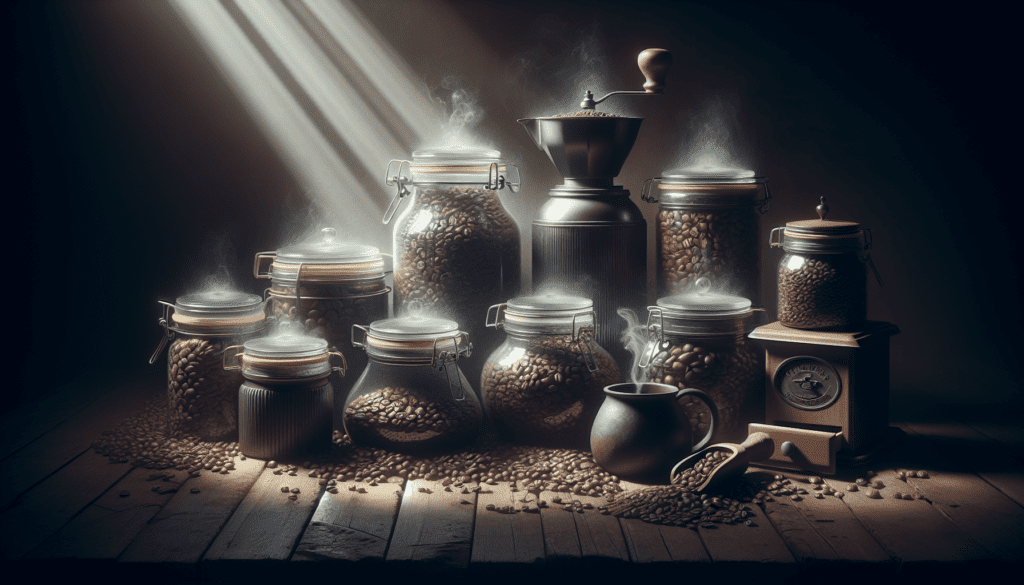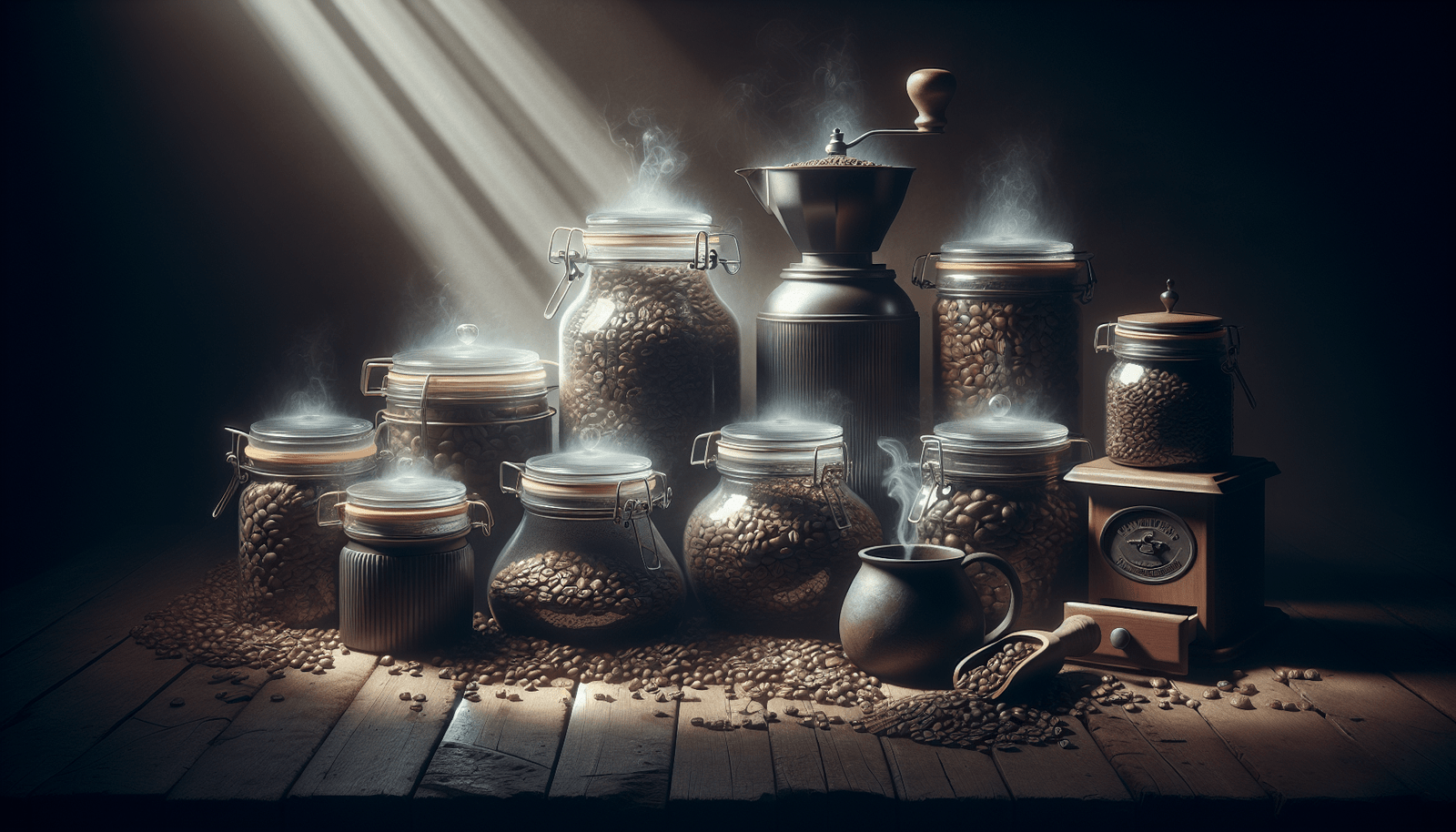If you’re a coffee lover, you understand the importance of storing coffee beans properly to preserve their freshness and flavor. Whether you have a cherished bag of dark roast or a container of gourmet coffee beans, knowing the best way to store them is essential. In this article, we’ll take you on a journey through the world of coffee beans, from their origins to the various flavors and brewing methods. Along the way, we’ll share expert tips on how to store your coffee beans to ensure they stay as delicious as the day you first got them. So grab your favorite mug and get ready to learn the secrets of storing coffee beans in the best way possible.

Storage Basics
When it comes to storing your beloved coffee beans, there are a few key factors to consider. By taking the necessary steps to protect your beans from exposure to air, moisture, direct sunlight, and fluctuations in temperature, you can ensure that they stay fresh and flavorful for as long as possible.
Preventing Exposure to Air
Air is one of the biggest enemies of coffee beans. When exposed to oxygen, the beans can quickly become stale and lose their aromatic qualities. To prevent this from happening, it’s important to store your beans in airtight containers that seal out the air. By keeping the air out, you can prolong the freshness of your coffee beans and maintain their rich flavors.
Keeping Away from Moisture
Moisture is another enemy of coffee beans. When beans absorb moisture, they can become moldy and develop an unpleasant taste. To protect your beans from moisture, it’s crucial to store them in a dry environment. Avoid placing your coffee beans near the sink or any other sources of water. Instead, opt for a cool and dry location to extend the shelf life of your beans.
Avoiding Direct Sunlight
Direct sunlight can have detrimental effects on the quality of your coffee beans. The heat and UV rays from the sun can accelerate the degradation of the beans, causing them to lose their flavor and aroma. It’s best to store your beans in a dark area, away from any windows or other sources of sunlight. By doing so, you can protect your beans from the harmful effects of direct sunlight and preserve their taste and freshness.
Maintaining a Consistent Temperature
Temperature fluctuations can have a significant impact on the quality of your coffee beans. Exposure to high temperatures can cause the beans to deteriorate more rapidly, while fluctuations between hot and cold can lead to condensation, which can in turn lead to moisture damage. It’s important to store your beans in an environment with a consistent temperature. Ideally, this temperature should be cool and moderate, as extreme heat or cold can negatively affect the taste and quality of your beans.
Preferred Containers
Choosing the right container for your coffee beans is essential for proper storage. There are a few key characteristics that you should look for in a container in order to preserve the freshness and flavor of your beans.
Airtight Containers
As mentioned earlier, airtight containers are crucial for preventing exposure to air. Look for containers with a secure seal that will keep out oxygen and maintain the freshness of your beans. Glass jars with airtight lids or specially designed coffee storage containers with built-in valves are great options for storing your beans.
Opaque Containers
To protect your beans from direct sunlight, it’s important to choose containers that are opaque or have a dark color. This will help to block out any light and preserve the quality of your beans. Avoid clear or transparent containers, as they will allow light to reach the beans and cause them to degrade more quickly.
Containers with One-Way Valve
Coffee beans release carbon dioxide gas after being roasted, and this gas needs to escape to prevent the containers from becoming pressurized. Containers with one-way valves allow the carbon dioxide to escape without letting oxygen in. This helps to maintain the freshness of the beans by preventing oxidation. Look for containers with these valves for optimal storage.
Choosing the Right Location
In addition to using the right containers, selecting the proper location for storing your coffee beans is equally important. The environment in which you store your beans can greatly impact their freshness and overall quality.
Dark and Cool Pantry
A dark and cool pantry is an ideal location for storing your coffee beans. The pantry should be away from any direct sources of light or heat. Optimal temperatures range from 55°F to 70°F (13°C to 21°C), as this range will help to preserve the flavors of the beans. Ensure that the pantry is well-sealed and free from any moisture or humidity.
Freezer
If you anticipate that you won’t be using your coffee beans for an extended period of time, storing them in the freezer can effectively prolong their shelf life. It’s important to note that freezing your beans can impact the flavor, so this is a better option for long-term storage rather than everyday use. Before freezing, make sure to properly package the beans to prevent any moisture or freezer burn.
Avoiding Refrigerator
Contrary to popular belief, storing coffee beans in the refrigerator is not recommended. The moisture and odors in the refrigerator can seep into the beans and affect their flavors. Additionally, the temperature fluctuations that occur when the refrigerator door is opened and closed can also impact the quality of the beans. For optimal results, avoid storing your coffee beans in the refrigerator.
Factors to Consider
When storing your coffee beans, there are a few factors that you should take into consideration to maximize their freshness and flavor.
Roast Date and Freshness
The freshness of your coffee beans greatly contributes to the overall quality of your brew. It’s important to pay attention to the roast date of your beans and try to use them within the first few weeks after roasting. After this time, the beans will start to lose their flavors and aromas. Whenever possible, opt for freshly roasted beans to ensure the best tasting cup of coffee.
Whole Beans vs Ground Beans
Whole beans generally retain their freshness and flavors better than ground beans. When you grind the beans, you expose them to more surface area, which can lead to faster degradation. If possible, it’s recommended to store your beans in their whole form and grind them just before brewing. This will help to preserve the flavors and aromas until the very last moment.
Quantity of Beans
Consider the quantity of beans you purchase and store at one time. It’s best to only buy what you can consume within a reasonable period to avoid beans going stale or losing their flavors. Buying smaller quantities more frequently is a good practice to ensure that you are always working with fresh coffee beans.

Preparing Beans for Storage
Before storing your coffee beans, there are a few important steps you should take to ensure optimal freshness.
Sealing the Bag Properly
If your coffee beans come in a bag with a resealable closure, make sure to seal it tightly after each use. Press out any excess air before sealing to minimize contact with oxygen. If the bag doesn’t have a resealable closure, consider transferring the beans to an airtight container.
Removing Excess Air
Whether you’re using a bag or a container to store your beans, it’s essential to remove as much excess air as possible. Oxygen can quickly degrade the flavor of your beans, so pressing out the air or using a vacuum sealer can help to maintain their freshness.
Transferring to a Container
If your coffee beans come in a bag that isn’t airtight or doesn’t have a one-way valve, it’s advisable to transfer them to an airtight container. This will provide better protection against air, moisture, and light. Choose a container that is the appropriate size for the quantity of beans you have and ensure that it has a secure seal to keep out oxygen.
Storing Different Types of Coffee Beans
Different types of coffee beans may have specific storage requirements due to variations in their composition and flavor profiles. Here are some tips for storing common types of coffee beans:
Arabica Coffee Beans
Arabica beans, known for their complex flavors and acidity, are best stored in airtight containers in a cool and dark place. They are more delicate and prone to oxidation compared to robusta beans, so proper storage is crucial in preserving their flavors.
Robusta Coffee Beans
Robusta beans, known for their bold and strong flavors, are generally more resilient than arabica beans. However, it’s still important to store them in airtight containers away from air, moisture, and light to maintain their quality over time.
Flavored Coffee Beans
Flavored coffee beans are infused with various flavors to enhance their taste. When storing flavored beans, it’s essential to keep them away from strong odors, as they can absorb the aromas and affect the flavors of the beans. Store them in airtight containers, separate from other types of coffee beans, to maintain their unique flavors.
Decaf Coffee Beans
Decaf coffee beans, which have undergone a process to remove caffeine, should be stored in the same manner as regular coffee beans. They can still lose their flavors and become stale if not stored properly. Follow the general guidelines of using airtight containers and keeping them away from air, moisture, and light.
Long-Term Storage
If you need to store your coffee beans for an extended period of time, there are a few additional measures you can take to ensure their longevity.
Vacuum Sealing
Vacuum sealing is an effective method for long-term storage of coffee beans. By removing all the air from the package, you can greatly reduce the chances of oxidation and maintain the freshness of the beans. Place the vacuum-sealed package in a cool and dark place for optimal preservation.
Freezing Coffee Beans
Freezing coffee beans is another option for long-term storage. However, it’s important to package the beans properly to prevent moisture and freezer burn. Divide the beans into smaller portions and store them in airtight containers or bags designed for freezer use. When you’re ready to use the beans, thaw only the necessary amount and avoid refreezing.
Proper Thawing Techniques
When thawing frozen coffee beans, it’s important to do so properly to minimize any adverse effects on their quality. Remove the beans from the freezer and let them thaw naturally at room temperature. Avoid using heat or hot water to thaw the beans, as this can cause moisture damage and affect the flavors.
Avoiding Common Mistakes
While it’s important to know the best practices for storing coffee beans, it’s equally vital to avoid common mistakes that can compromise their quality and flavor.
Storing in Clear Containers
Clear containers may be aesthetically pleasing, but they allow light to reach the beans and can cause them to deteriorate quickly. It’s best to choose dark or opaque containers that provide protection against sunlight. This will help to preserve the flavors and aromas of your coffee beans.
Using the Original Packaging
The original packaging of coffee beans may not always be ideal for long-term storage. The bags often lack airtight seals or one-way valves, making them susceptible to air, moisture, and light. It’s advisable to transfer the beans to airtight containers to better protect their freshness and flavors.
Storing in the Foil Bag
Some coffee beans come packaged in a foil bag with a valve. While these bags do provide some protection against air, they are not airtight and may still allow oxygen to degrade the beans over time. It’s best to transfer the beans to airtight containers for optimal storage.
Monitoring Shelf Life
To ensure that you’re using your coffee beans at their peak freshness, it’s important to monitor their shelf life and know when they may start to degrade.
Taste and Aroma Evaluation
Regularly brew and taste your coffee to evaluate its flavors and aromas. As coffee beans age, their flavors become dull and their aromas may fade. Pay attention to any changes in the taste and aroma of your brewed coffee, as this can be an indicator that your beans are no longer at their best.
Signs of Degradation
In addition to monitoring the taste and aroma, there are a few physical signs that can indicate that your coffee beans are degrading. Look out for any visible mold or discoloration on the beans. If the beans feel overly dry or oily, this can also suggest that they have lost their freshness and quality.
Recommended Consumption Time
While coffee beans can technically be stored for several months, it’s generally recommended to use them within three to four weeks of the roast date for optimal freshness and flavor. The sooner you consume the beans after roasting, the better the taste and aroma will be.
Conclusion
Proper storage is essential for maintaining the freshness and flavor of your coffee beans. By following the guidelines outlined in this article, you can ensure that your beans stay in their best condition for as long as possible. From choosing the right containers and location to avoiding common mistakes and monitoring shelf life, taking these steps will help you enjoy a consistently delicious cup of freshly-brewed coffee. So go ahead, store your coffee beans with care, and savor the rich flavors and aromas they have to offer.

